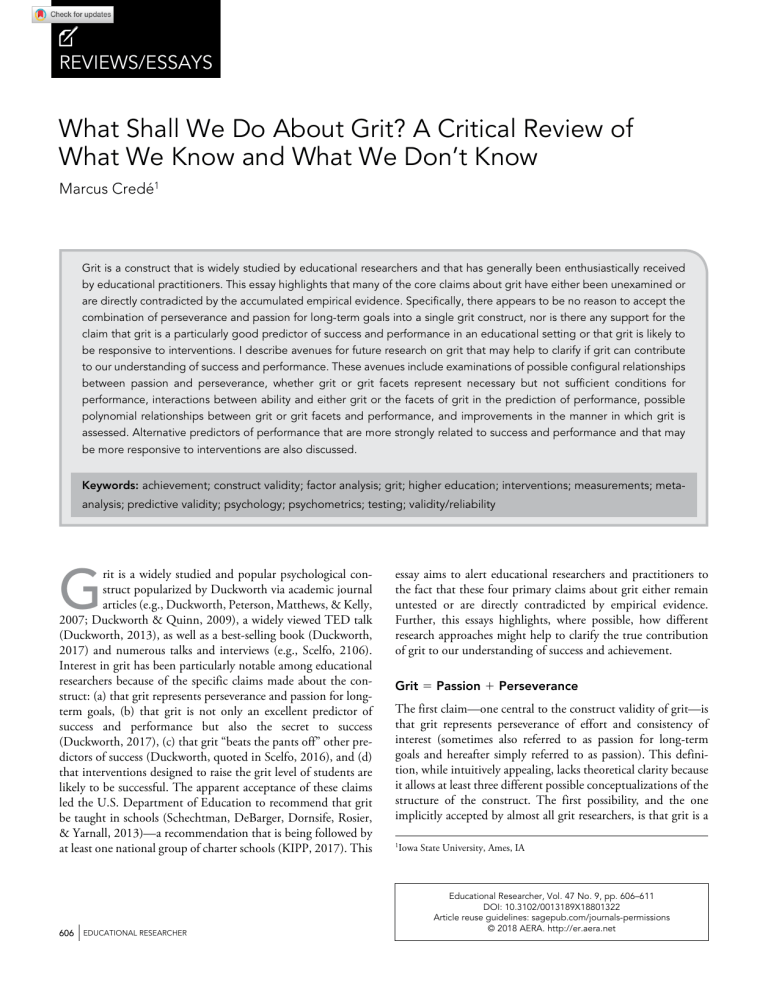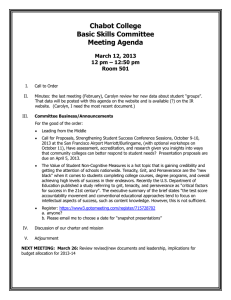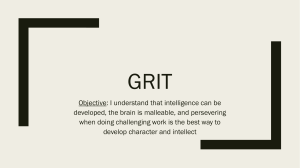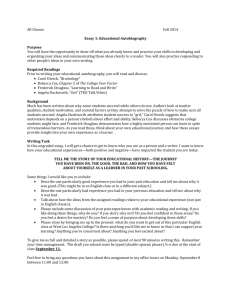
801322 review-article2018 EDRXXX10.3102/0013189X18801322Educational ResearcherEducational Researcher Reviews/Essays What Shall We Do About Grit? A Critical Review of What We Know and What We Don’t Know Marcus Credé1 Grit is a construct that is widely studied by educational researchers and that has generally been enthusiastically received by educational practitioners. This essay highlights that many of the core claims about grit have either been unexamined or are directly contradicted by the accumulated empirical evidence. Specifically, there appears to be no reason to accept the combination of perseverance and passion for long-term goals into a single grit construct, nor is there any support for the claim that grit is a particularly good predictor of success and performance in an educational setting or that grit is likely to be responsive to interventions. I describe avenues for future research on grit that may help to clarify if grit can contribute to our understanding of success and performance. These avenues include examinations of possible configural relationships between passion and perseverance, whether grit or grit facets represent necessary but not sufficient conditions for performance, interactions between ability and either grit or the facets of grit in the prediction of performance, possible polynomial relationships between grit or grit facets and performance, and improvements in the manner in which grit is assessed. Alternative predictors of performance that are more strongly related to success and performance and that may be more responsive to interventions are also discussed. Keywords: achievement; construct validity; factor analysis; grit; higher education; interventions; measurements; metaanalysis; predictive validity; psychology; psychometrics; testing; validity/reliability G rit is a widely studied and popular psychological construct popularized by Duckworth via academic journal articles (e.g., Duckworth, Peterson, Matthews, & Kelly, 2007; Duckworth & Quinn, 2009), a widely viewed TED talk (Duckworth, 2013), as well as a best-selling book (Duckworth, 2017) and numerous talks and interviews (e.g., Scelfo, 2106). Interest in grit has been particularly notable among educational researchers because of the specific claims made about the construct: (a) that grit represents perseverance and passion for longterm goals, (b) that grit is not only an excellent predictor of success and performance but also the secret to success (Duckworth, 2017), (c) that grit “beats the pants off” other predictors of success (Duckworth, quoted in Scelfo, 2016), and (d) that interventions designed to raise the grit level of students are likely to be successful. The apparent acceptance of these claims led the U.S. Department of Education to recommend that grit be taught in schools (Schechtman, DeBarger, Dornsife, Rosier, & Yarnall, 2013)—a recommendation that is being followed by at least one national group of charter schools (KIPP, 2017). This 606 EDUCATIONAL RESEARCHER essay aims to alert educational researchers and practitioners to the fact that these four primary claims about grit either remain untested or are directly contradicted by empirical evidence. Further, this essays highlights, where possible, how different research approaches might help to clarify the true contribution of grit to our understanding of success and achievement. Grit = Passion + Perseverance The first claim—one central to the construct validity of grit—is that grit represents perseverance of effort and consistency of interest (sometimes also referred to as passion for long-term goals and hereafter simply referred to as passion). This definition, while intuitively appealing, lacks theoretical clarity because it allows at least three different possible conceptualizations of the structure of the construct. The first possibility, and the one implicitly accepted by almost all grit researchers, is that grit is a 1 Iowa State University, Ames, IA Educational Researcher, Vol. 47 No. 9, pp. 606­–611 DOI: 10.3102/0013189X18801322 Article reuse guidelines: sagepub.com/journals-permissions © 2018 AERA. http://er.aera.net higher order construct comprised of two first-order facets: perseverance and passion. At first glance, this claim may not appear to be particularly problematic; it is certainly likely to hold an intuitive appeal for educators who recognize that many students in their classes and institutions have struggled because of a lack of perseverance and/or a lack of passion for long-term goals. But why should perseverance and passion be combined into a single grit variable? Can we combine any two moderately correlated psychological variables and call the resultant variable something that has psychological meaning? A scientific claim that a variable—here grit—represents the combination of two or more constructs—here perseverance and passion—must find strong empirical support beyond mere intuitive appeal. Luckily there is a sophisticated and growing literature that discusses the types of evidence that researchers should marshal when making the argument for a higher order construct such as grit. For example, Johnson, Rosen, Chang, Djurdevic, and Taing (2012) describe seven types of evidence that should be presented when arguing for a higher order construct, while my colleague and I outline the specific types of factor analytic results that would constitute support for a higher order construct (Credé & Harms, 2015). Broadly speaking, a proposed higher order construct is supported under three broad conditions: (1) the facets are strongly and relatively uniformly correlated with each other, (2) a higher order model exhibits fit that is better (or at least no worse) than all plausible alternative models of how the facets are related to each other, and (3) aggregating across facets to form a higher order construct does not diminish our ability to predict outcomes relative to simply retaining the facets as standalone constructs. The theoretical higher order structure was formally examined by Duckworth and Quinn (2009) via confirmatory factor analysis and is also implied by the aggregation of perseverance scores and passion scores to form an overall grit score—a scoring approach that was explicitly endorsed by Duckworth et al. (2007, p. 1091). While widely accepted, this higher order view of the structure of grit does not appear to be correct for three important reasons. First, the higher order view essentially equates individuals with high levels of perseverance and low levels of passion with those individuals who have low levels of perseverance and high levels of passion. That is, both individuals would be described as having average levels of grit. Second, the higher order factor analytic model tested by Duckworth and Quinn (2009) is unidentified at the higher order level. What this means, in essence, is that the authors tried to solve the equation a * b = x, where a and b represent the paths from the lower order facets to the second order construct and x is a constant (here the correlation between perseverance and passion). Most readers will recognize that for any given value of x, a and b can take on an infinite number of combinations of values. That is, there is no unique solution for a and b, and factor analytic software will typically inform the user of this problem in the output. Further, the fit of this model will always be identical to the fit of the most plausible alternative model in which the perseverance and passion are simply kept as separate albeit correlated variables. This, in turn, means that the factor analytic solution offered by Duckworth and Quinn (which contains precise values for a and b, see Figure 1 on p. 168 of Duckworth & Quinn, 2009) cannot be used to infer support for a higher order model. Third, the aggregation of facet-level scores into an overall score is only supported if such an aggregation does not result in a loss in criterion validity (see Johnson et al., 2012, for a discussion). However, our recent meta-analysis of the grit literature (Credé, Tynan, & Harms, 2017), based on data from 88 samples and over 66,000 individuals, demonstrates that overall grit scores do not predict success and performance as well as a model in which perseverance and passion are considered separately. In other words, researchers would be able to predict success and performance much better if they kept perseverance and passion separate rather than combining them to form a single grit score. Because the higher order view of grit does not appear to be supported, researchers may consider two alternative conceptualizations of the structure of grit. The first alternative conceptualization is that grit represents the unique combination of high levels of perseverance and (simultaneously) high levels of passion. This person-centered approach would, in turn, imply that grit does not exist on a low-to-high continuum and that an individual with high levels of perseverance but low levels of passion (or vice versa) should not be described as having moderate amounts of grit. Instead, individuals would be described as having grit or not having grit—although the “not gritty” group could certainly be divided into further subgroups (e.g., low on passion, low on perseverance, and low on both passion and perseverance). This conceptualization of grit is hinted at by Duckworth et al. (2007), who describe particularly successful historical figures as being characterized by “zeal and with capacity for hard labor” (quote from Galton, 1892 on p. 1088 of Duckworth et al., 2007). To my knowledge, this person-centered approach to understanding grit has never been tested; doing so should be relatively straightforward using latent class analysis, other cluster analytic approaches, or even Necessary Condition Analysis (Dul, 2016). A third possible conceptualization is that the importance of perseverance as a predictor of success is contingent on the individual’s level of passion (and vice versa). That is, perseverance may be a modest predictor of success on its own—as we suggested in our meta-analysis (Credé et al., 2017)—but the relationship between perseverance and performance may be significantly stronger when passion is high. This, of course, would represent a moderation effect that would best be tested using standard regression-based or structural equation-based methods for testing interaction effects. To my knowledge, the possible interaction between perseverance and passion in determining success has also not been tested. A final important problem with the claim that grit is a combination of perseverance and passion is that grit scores and perseverance scores are so strongly correlated with one of the Big Five personality traits—conscientiousness—as to suggest that overall grit and perseverance as currently assessed are simply a relabeling of conscientiousness. This apparent “old wine in new bottles” phenomenon suggests that enthusiasm for grit may largely be based on the jangle fallacy, which is the belief that two December 2018 607 very similar things are distinct merely because they have different names. The apparent isomorphism with conscientiousness and strong overlap with other related constructs such as selfcontrol (see Muenks, Wigfield, Yang, & O’Neal, 2017) also severely limits the contribution of grit to our understanding of success because the influence of conscientiousness on success has a very long prior research tradition and is generally well understood (e.g., see meta-analytic reviews by Porapat, 2009, 2014). This finding was reinforced both in our meta-analysis (Credé et al., 2017), in which we estimated that overall grit and perseverance were correlated with conscientiousness at r = .84 and r = .83, respectively, and a study of 2,321 pairs of twins (Rimfeld, Kovas, Dale, & Plomin, 2016), which found that perseverance and conscientiousness exhibited a genetic correlation of r = .86. The relationship of passion with conscientiousness is also strong (r = .61; Credé et al., 2017) but not so strong as to suggest that passion is entirely redundant with conscientiousness. Grit as a Predictor of Success and Performance The second core claim is that grit is an excellent predictor of success and performance and that it is a defining feature of high achievement. In support of this argument, the proponents of grit marshal two lines of evidence. The first line of evidence is represented by interviews with professionals in various industries and prior work on high achievement and genius by the likes of Galton (1892), Cox (1926), and Howe (1999). These sources all emphasized that qualities like hard work, passion, and perseverance were critical features of successful individuals. The second line of evidence is based on correlational data that Duckworth and her co-authors collected in a variety of military, occupational, educational, and social settings (e.g., Duckworth et al., 2007; Duckworth & Quinn, 2009; Eskreis-Winkler, Duckworth, Shulman, & Beal, 2014). These data are also presented as supporting the value of grit scores as good predictors of success. A closer look at these two lines of evidence suggests that the support for grit as a defining feature of success is limited. The first problem is simply that historical accounts of high achievement and genius are susceptible to what is referred to as survivorship bias (see Smith, 2014). That is, while it may be correct that many past high achievers were characterized by high levels of perseverance and passion, we are unable to know from this evidence if perseverance and passion were predictors and causes of success. Perhaps there was a similar group of individuals (perhaps a much larger group) who also had high levels of perseverance and passion but who did not achieve or who perhaps even failed spectacularly and devastatingly because their high levels perseverance or passion were manifested in an inability to ask for help or change course even when such behavior might have been functional or appropriate. For example, it is true that many successful fiction authors such as J.K. Rowling and William Golding labored for years on their manuscripts and persevered through many rejections from publishers and editors, but there are probably far more aspiring authors who labored with similar perseverance and passion but who never succeeded in getting their manuscript published or who failed to become successful authors. Unfortunately, we seldom hear from this much larger 608 EDUCATIONAL RESEARCHER group of writers. More importantly, these unsuccessful authors may have sacrificed success in other fields to their persistent pursuit of their passion for writing. Focusing only on those who succeeded provides a distorted perspective on the importance of perseverance and passion as a predictor of success in this specific discipline. The empirical data collected by Duckworth and colleagues also offers only limited support for the claim that grit is a good predictor of success—notwithstanding some of the more hyperbolic claims about the predictive value of grit made to members of the media (e.g., Scelfo, 2016). Indeed, in many of the samples collected by Duckworth herself, grit scores are often shown to be only very weak predictor of success, while other variables such as admissions test scores, cognitive ability, or physical ability are much better predictors (e.g., Eskreis-Winkler et al., 2014). The generally weak relationship between grit and performance was also confirmed by our recent meta-analytic review of the grit literature (Credé et al., 2017), which also noted that two of the stronger claims about the effectiveness of grit as a predictor of success appear to be based on a statistical misunderstanding. The proponents of grit have not only claimed that grit is an excellent predictor of success but also that grit is a better predictor of success than other variables such as cognitive ability, admissions test scores, or physical fitness (e.g., Scelfo, 2016). This too does not appear to be correct. The meta-analytic estimate of the relationship between overall grit and academic performance (r = .18) is much weaker than the correlation that has been observed for other variables. For example, meta-analytic reviews have shown that admissions test scores (r = .40 to r = .60, Kuncel & Hezlett, 2007), study skills and study habits (r = .40; Credé & Kuncel, 2008), academic adjustment (r = .39, Credé & Niehorster, 2012), class attendance (r = .41, Credé, Roch, & Kieszczynska, 2010), and effort regulation and metacognition (r = .23 to r = .40, Credé & Phillips, 2011) are much better predictors of college and graduate school achievement, while cognitive ability is a much better predictor of job performance (r = .24 to r = .58, Schmidt & Hunter, 2004). My colleagues and I (Credé et al., 2017) have also demonstrated that grit explains almost no incremental variance in performance after controlling for conscientiousness. Researchers examining the incremental value of grit scores over other predictors of performance should always control for conscientiousness because of its apparent isomorphism with grit. Where does this leave researchers who are interested in further exploring the relationship between grit and performance or success? A number of possibilities present themselves. First, researchers might consider whether grit interacts with ability in determining performance. That is, perhaps grit becomes a better predictor of success among individuals who have the level of innate ability or skill that is required to excel at a particular task. For example, becoming an expert musician may require high levels of innate musical talent combined with high levels of grit; either one alone is not sufficient for developing expertise. This possibility has been hinted at by Duckworth in her arguments for a polynomial relationship between ability and grit/effort (specifically effort squared; see Duckworth, Eichstaedt, & Ungar, 2015). In other words, grit and ability might both be necessary but not sufficient conditions for success and performance. It is also possible that noncognitive attributes such as grit are particularly important for individuals at the lower end of the ability spectrum. Findings described by Heckman and Rubinstein (2001) and Lindqvist and Vestman (2011) suggest that noncognitive attributes may help individuals who did not graduate from college to avoid various negative behaviors and outcomes such as frequent switching of jobs, low wages, and even drug use and criminal activity. Exploring this possibility will require researchers to explore the use of moderated regression, Necessary Condition Analysis (Dul, 2016), or other configural relationships between grit, ability, and success. A second possibility is that the value of grit is situationally determined such that grit interacts with situational characteristics in determining success or performance. In other words, grit may be particularly valuable in situations characterized by high levels of adversity, ambiguity, and complexity such that almost all individuals will initially fail to perform well. That is, individuals must overcome the initial experiences of failure and persist for lengthy periods of time before a high level of performance can be attained. A third possibility is to investigate whether alternative operationalizations of grit may result in stronger relationships with criterion. The existing grit scales are psychometrically unsatisfactory because of the complete confounding of the perseverance and passion scales with positively worded and negatively worded items, respectively. Negatively worded items are psychometrically problematic because they are known to be more difficult to answer (Swain, Weathers, & Niedrich, 2008), especially for individuals with lower levels of reading ability (e.g., Marsh, 1986), and also because they can lower the reliability and validity of scale scores (Woods, 2006) and artificially create distinct factors (e.g., Schmitt & Stults, 1985). It may therefore be better to either have positively and negatively worded items for both subscales or to only have positively worded items. It is also worth noting that the short grit scale (Duckworth & Quinn, 2009) is particularly poorly aligned with the theoretical conceptualization of grit because the items make almost no mention of maintaining interest and passion despite failures and setbacks—a core element of the definition of grit (see Duckworth et al., 2007). Revisiting the measurement of grit may help researchers arrive at a more accurate understanding of the role of grit in determining performance, and there appear to be at least four ways in which the measurement of grit could be refined. First, negatively worded items should be eliminated and replaced with positively worded items. Second, item response theory (IRT) methods may help to develop items that improve on the ability to accurately measure the grit construct at all levels of the construct. That is, it is unclear whether the existing scales are effective at measuring very high and very low levels of either of the two facets. Importantly, IRT item refinement should be based on a consideration of each of the two facets individually because IRT methods are based on an assumption of unidimensionality. Third, it may be helpful to provide situational contexts for grit items— ideally, contexts that match the criterion of interest (see Lievens, De Corte, & Schollaert, 2008). For example, asking respondents about their level of grit when engaged in academic tasks may improve the criterion validity of grit scores for academic performance. Fourth, researchers may consider developing observer rating forms such as those used by Robertson-Kraft and Duckworth (2014) or even situational judgment test items for the measurement of grit in order to reduce the influence of socially desirable responding. Self-ratings are likely to be of only limited value because they require high levels of self-awareness from respondents. The Impact of Grit Interventions Despite the very modest relationship of grit scores with performance and the lack of evidence that grit scores reflect much beyond conscientiousness, proponents of grit may still believe that interventions designed to enhance grit will have some value. The questionable validity of combining perseverance and passion into a single construct suggests that research on the efficacy of such interventions should examine interventions designed to increase perseverance and interventions designed to increase passion separately. However, evidence from the personality literature suggests that interventions designed to increase perseverance—a construct that appears to be isomorphic with conscientiousness—are likely to be of limited value. A recent meta-analysis of the literature on interventions designed to change personality (Roberts et al., 2017) found that clinical interventions designed to increase conscientiousness have only small effects (d = .19 and d = .06 for pre-post intervention and treatment-control group comparisons, respectively). Interventions designed to increase skills that are related to conscientiousness, such as study skills, have had somewhat greater success (d = .45; see meta-analysis by Hattie, Biggs, & Purdie, 1996), but in general interventions designed to change perseverance are likely to require long-term investment by institutions and the involvement of well-trained and skilled teachers and trainers. It may also be useful to design interventions in a way that highlights which situations may require students to respond with perseverance and in which situations perseverance may be less adaptive—in much the same way that the literature on self-regulated learning has emphasized the need to adapt learning approaches to the demands of the situation (see Zimmerman, 1990). Interventions designed to increase passion face a more theoretical obstacle inasmuch as it is unclear whether a general increase in passion is desirable. Passion for academic subjects, music, or sport may increase the likelihood of developing expertise in these domains, but passion for other pursuits (e.g., playing of video games) may have less desirable consequences. Similarly, it is as yet unclear whether an individual’s general level of passion can be increased by interventions or whether high levels of passion for long-terms goals are even inherently desirable, particularly for younger children who may benefit more from a general exploration of many different activities rather than the singleminded pursuit of any one activity. Take, for example, the items “My interests change from year to year” and “I have been obsessed with a certain idea or project for a short time but later lost interest.” These reverse-scored items, taken from the original 12-item grit scale, are designed to assess passion, but it seems questionable whether any school intervention should aim to December 2018 609 ensure that children do not change their interests from year to year when the exploration of interests is viewed by some as a critical component of childhood and adolescence (e.g., Hofer, 2010). Where Do We Go From Here? For all its intuitive appeal, the grit literature is currently characterized by a number of serious theoretical and empirical challenges ranging from a lack of construct validity, discriminant validity, and predictive validity. At present there is no empirical support for the idea that grit is the combination of perseverance and passion or for the claim that grit adds to our understanding of success and performance. Indeed, the best available evidence strongly suggests that grit is largely a repackaging of ­conscientiousness—a widely studied personality trait. If grit is to represent a meaningful contribution to our understanding of success, researchers should focus on three broad areas. First, future work will have to pay particularly close attention to whether the combination of perseverance and passion into a single construct can be theoretically or empirically justified or whether the two facets are best studied individually. Second, future work should consider whether grit or grit facets interact with ability to predict success or whether grit facets represent necessary-but-not-sufficient conditions for success. Third, efforts should be made to improve the measurement of grit and grit facets because any empirical investigation of the role of grit requires that grit be measured better than current scales allow. Until grit researchers have provided better evidence regarding the role that grit plays in determining success, it seems reasonable to advise educational institutions to focus their often-­ limited financial and instructional resources on variables that have stronger relationships with success and performance and that can be more easily changed via interventions. References Cox, C. M. (1926). Genetic studies of genius: Vol. 2. The early mental traits of three hundred geniuses. Stanford, CA: Stanford University Press. Credé, M., & Harms, P. D. (2015). 25 years of higher-order confirmatory factor analysis in the organizational sciences: A critical review and development of reporting recommendations. Journal of Organizational Behavior, 36, 845–872. Credé, M., & Kuncel, N. R. (2008). Study habits, study skills, and study attitudes: The third pillar supporting collegiate academic performance. Perspectives on Psychological Science, 3, 415–453. Credé, M., & Niehorster, S. (2012). Adjustment to college as measured by the Student Adaptation to College Questionnaire: A quantitative review of its structure and relationships with correlates and consequences. Educational Psychology Review, 24, 133–165. Credé, M., & Phillips, L. A. (2011). A meta-analytic review of the Motivated Strategies for Learning Questionnaire. Learning and Individual Differences, 21, 337–346. Credé, M., Roch, S., & Kieszczynska, U. M. (2010). Class attendance in college: A meta-analytic review of the relationship of class attendance with grades and student characteristics. Review of Educational Research, 80, 272–295. Credé, M., Tynan, M., & Harms, P. D. (2017). Much ado about grit: A meta-analytic synthesis of the grit literature. Journal of Personality and Social Psychology, 113, 492–511. 610 EDUCATIONAL RESEARCHER Duckworth, A. L. (2013). The key to success? Grit. Retrieved from https://www.ted.com/talks/angela_lee_duckworth_the_key_to_ success_grit?language_en#t-9644 Duckworth, A. L. (2017). Grit—Why passion and resilience are the secrets to success. London, UK: Vermilion. Duckworth, A. L., Eichstaedt, J. C., & Ungar, L. H. (2015). The mechanics of human achievement. Social and Personality Psychology Compass, 9, 359–369. Duckworth, A. L., Peterson, C., Matthews, M. D., & Kelly, D. R. (2007). Grit: Perseverance and passion for long term goals. Journal of Personality and Social Psychology, 92, 1087–1101. Duckworth, A. L., & Quinn, P. D. (2009). Development and validation of the short grit scale (Grit-S). Journal of Personality Assessment, 91, 166–174. Dul, J. (2016). Necessary condition analysis (NCA). Organizational Research Methods, 19, 10–52. Eskreis-Winkler, L., Duckworth, A. L., Shulman, E. P., & Beal, S. (2014). The grit effect: Predicting retention in the military, the workplace, school and marriage. Frontiers in Psychology, 5, 36. Galton, F. (1892). Hereditary genius: An inquiry into its laws and consequences. London, UK: Macmillan. Hattie, J., Biggs, J., & Purdie, N. (1996). Effects of learning skills interventions on student learning: A meta-analysis. Review of Educational Research, 66, 99–136. Heckman, J. J., & Rubinstein, Y. (2001). The importance of non-­ cognitive skills: Lessons from the GED testing program. The American Economic Review, 91, 145–149. Hofer, M. (2010). Adolescents’ development of individual interests: A product of multiple goal regulation? Educational Psychologist, 45, 149–166. Howe, M. J. A. (1999). Genius explained. New York, NY: Cambridge University Press. Johnson, R. E., Rosen, C. C., Chang, C., Djurdevic, E., & Taing, M. U. (2012). Recommendations for improving the construct clarity of higher-order multidimensional constructs. Human Resource Management Review, 22, 62–72. KIPP. (2017). Character strengths. Retrieved September, 11, 2017, from http://www.kipp.org/approach/character/ Kuncel, N. R., & Hezlett, S. A. (2007). Standardized tests predict graduate students’ success. Science, 315, 1080–1081. Lievens, F., De Corte, W., & Schollaert, E. (2008). A closer look at the frame-of-reference effect in personality scale scores and validity. Journal of Applied Psychology, 93, 268–279. Lindqvist, E., & Vestman, R. (2011). The labor market returns to cognitive and non-cognitive ability: Evidence from the Swedish enlistment. American Economic Journal: Applied Economics, 3, 101–128. Marsh, H. W. (1986). Negative item bias in ratings scales for preadolescent children: A cognitive-developmental phenomenon. Developmental Psychology, 22, 37–49. Muenks, K., Wigfield, A., Yang, J. S., & O’Neal, C. R. (2017). How true is grit? Assessing its relations to high school and college students’ personality characteristics, self-regulation, engagement, and achievement. Journal of Educational Psychology, 109, 599–620. Porapat, A. E. (2009). A meta-analysis of the five-factor model of personality and academic performance. Psychological Bulletin, 135, 322–338. Porapat, A. E. (2014). A meta-analysis of adult-rated personality and academic performance in primary education. British Journal of Educational Psychology, 84, 239–252. Rimfeld, K., Kovas, Y., Dale, P. S., & Plomin, R. (2016). True grit and genetics: Predicting academic achievement from personality. Journal of Personality and Social Psychology, 111, 780–789. Roberts, B. W., Luo, J., Briley, D. A., Chow, P. I., Su, R., & Hill, P. L. (2017). A systematic review of personality trait change through intervention. Psychological Bulletin, 143, 117–141. Robertson-Kraft, C., & Duckworth, A. (2014). True-grit: Trait level perseverance and passion for long-term goals predicts effectiveness and retention among novice teachers. Teachers College Records, 116(3). Scelfo, J. (2016, April 8). Angela Duckworth on passion, grit, and success. The New York Times. Retrieved from https://www.nytimes. com/2016/04/10/education/edlife/passion-grit-success.html Schechtman, N., DeBarger, A. H., Dornsife, C., Rosier, S., & Yarnall, L. (2013). Promoting grit, tenacity, and perseverance: Critical factors for success in the 21st century. Washington, DC: U.S. Department of Education, Office of Education Technology. Retrieved from http://pgbovine.net/OET-Draft-Grit-Report-2-17-13.pdf Schmidt, F. L., & Hunter, J. (2004). General mental ability in the world of work: Occupational attainment and job performance. Journal of Personality and Social Psychology, 86, 162–173. Schmitt, N., & Stults, D. M. (1985). Factors defined by negatively keyed items: The result of careless respondents? Applied Psychological Measurement, 9, 367–373. Smith, G. (2014). Standard deviations: Flawed assumptions, tortured data, and other ways to lie with statistics. New York, NY: The Overlook Press. Swain, S. D., Weathers, D., & Niedrich, R. W. (2008). Assessing three sources of misresponse to reversed Likert items. Journal of Marketing Research, 45, 116–131. Woods, C. M. (2006). Careless responding to reverse-worded items: Implications for confirmatory factor analysis. Journal of Psychopathology and Behavioral Assessment, 28, 189–194. Zimmerman, B. J. (1990). Self-regulation and academic achievement: An overview. Educational Psychologist, 25, 3−17. Author MARCUS CREDÉ, PhD, is an assistant professor at Iowa State University, Department of Psychology, W112 Lagomarcino Hall, 901 Stange Road, Ames, IA 50011; mcrede@iastate.edu. His research focuses on noncognitive predictors of success and performance and the methodological challenges encountered when doing research in this domain. Manuscript received November 27, 2017 Revisions received May 2, 2018, and August 10, 2018 Accepted August 20, 2018 December 2018 611





